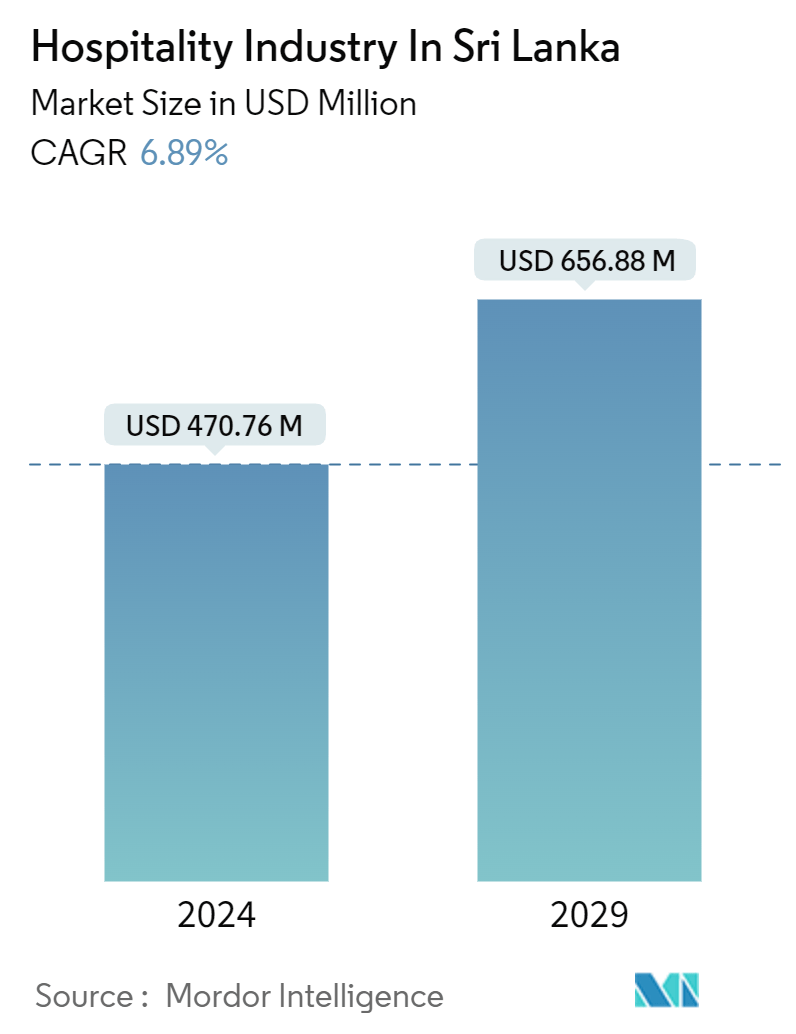Market Size of Hospitality Industry In Sri Lanka

| Study Period | 2020 - 2029 |
| Base Year For Estimation | 2023 |
| Market Size (2024) | USD 470.76 Million |
| Market Size (2029) | USD 656.88 Million |
| CAGR (2024 - 2029) | 6.89 % |
| Market Concentration | Low |
Major Players
*Disclaimer: Major Players sorted in no particular order |
Sri Lanka Hospitality Market Analysis
The Hospitality Industry In Sri Lanka Market size is estimated at USD 470.76 million in 2024, and is expected to reach USD 656.88 million by 2029, growing at a CAGR of 6.89% during the forecast period (2024-2029).
The Sri Lankan hospitality industry, which includes resort hotels, boutique accommodations, homestays, and traditional Sri Lankan restaurants, is crucial to the nation's tourism industry and economic health, serving as the third-largest source of revenue through foreign exchange earnings.
The industry has consistently been a top earner from tourism, establishing the country as an essential income source and offering attractive opportunities for investors and traders. The government has initiated plans to improve the country's beach and island tourism.
Port City Colombo (PCC) is at the forefront of transforming Sri Lanka into a premier tourist destination, attracting global travelers and investors with its commitment to sustainability, innovation, and exceptional hospitality, signaling a new chapter for the tourism industry.
The country prides itself on a collection of world-class hotels, resorts, boutique accommodations, and a dynamic culinary landscape. While already featuring luxury dining and a variety of cuisine, Sri Lanka is further investing in leisure and recreational activities, including three renowned golf courses in Nuwara Eliya, Kandy, and Colombo.
Despite these offerings, there is considerable room for growth, particularly in regions beyond the Western Province, where entertainment complexes and amusement parks are concentrated. This presents a significant opportunity for the expansion of such facilities throughout the island.
Sri Lanka Hospitality Industry Segmentation
Hospitality means receiving and entertaining guests in a way that makes them feel well taken care of. It leverages ambiance, service, and products or amenities to provide guests with the best experience possible.
The Sri Lankan hospitality industry is segmented by type and segment. By type, the market is segmented into chain hotels and independent hotels. By segment, the market is divided into service apartments, budget and economy hotels, mid and upper-mid-scale hotels, and luxury hotels. The report offers market sizes and forecasts in terms of value (USD) for all the above-mentioned segments.
| By Type | |
| Chain Hotels | |
| Independent Hotels |
| By Segment | |
| Service Apartments | |
| Budget and Economy Hotels | |
| Mid and Upper-mid-scale Hotels | |
| Luxury Hotels |
Hospitality Industry In Sri Lanka Size Summary
The Sri Lankan hospitality industry is a vital part of the country's cultural and economic landscape, significantly contributing to the tourism sector, which is a major source of foreign exchange and employment. The industry offers a diverse range of accommodations, from luxury resorts and city hotels to boutique establishments and homestays, catering to both local and international tourists. Despite facing challenges such as political instability and economic crises, the sector is poised for growth, driven by increasing tourist arrivals and government initiatives to boost tourism development. The presence of international hotel chains and the development of new accommodations, particularly in urban and coastal areas, are expected to enhance the industry's capacity and appeal.
The market is characterized by a mix of international and local players, leading to intense competition across various segments. However, the unique location and architectural appeal of hotels serve as key differentiators. The industry is also witnessing a rise in small and medium enterprises, contributing to the growth of guest houses and homestay units. Government efforts, such as the introduction of a mobile app for tourist safety and the 'Tourism Bio Bubble' concept, aim to restore and enhance tourist confidence. The increasing disposable income and travel interest among the middle class and millennials further support the industry's expansion, making it a promising area for investment and development.
Hospitality Industry In Sri Lanka Market Size - Table of Contents
-
1. MARKET INSIGHTS AND DYNAMICS
-
1.1 Market Overview
-
1.2 Market Drivers
-
1.2.1 Rise in the Tourism Industry
-
1.2.2 Increase in the Number of Hotel Projects and Investments
-
-
1.3 Market Restraints
-
1.3.1 Sustainability and Competition Threaten Industry Success
-
-
1.4 Market Opportunities
-
1.4.1 Government Initiatives Can Be Used to Expand the Horizons of the Industry
-
1.4.2 Online Marketing Can Be Leveraged to Expand the Customer Base
-
-
1.5 Value Chain / Supply Chain Analysis
-
1.6 Industry Attractiveness: Porter's Five Forces Analysis
-
1.6.1 Threat of New Entrants
-
1.6.2 Bargaining Power of Buyers
-
1.6.3 Bargaining Power of Suppliers
-
1.6.4 Threat of Substitutes
-
1.6.5 Intensity of Competitive Rivalry
-
-
1.7 Impact of COVID-19 on the Hospitality Industry
-
1.8 Insights into Revenue Flows from the Accommodation and Food and Beverage Sectors
-
1.9 Leading Cities in Sri Lanka with Respect to Number of Visitors
-
1.10 Investments (Real Estate, FDI, and Others) in the Hospitality Industry
-
1.11 Technological Innovations in the Hospitality Industry
-
1.12 Insights into Shared Living Spaces' Impact on the Hospitality Industry
-
1.13 Insights into Other Economic Contributors to the Hospitality Industry
-
-
2. MARKET SEGMENTATION
-
2.1 By Type
-
2.1.1 Chain Hotels
-
2.1.2 Independent Hotels
-
-
2.2 By Segment
-
2.2.1 Service Apartments
-
2.2.2 Budget and Economy Hotels
-
2.2.3 Mid and Upper-mid-scale Hotels
-
2.2.4 Luxury Hotels
-
-
Hospitality Industry In Sri Lanka Market Size FAQs
How big is the Hospitality Industry In Sri Lanka Market?
The Hospitality Industry In Sri Lanka Market size is expected to reach USD 470.76 million in 2024 and grow at a CAGR of 6.89% to reach USD 656.88 million by 2029.
What is the current Hospitality Industry In Sri Lanka Market size?
In 2024, the Hospitality Industry In Sri Lanka Market size is expected to reach USD 470.76 million.

